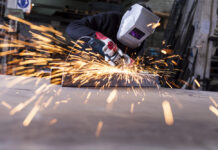Precast concrete is a type of concrete that is manufactured off-site in a factory environment. Precast concrete is a durable, strong and versatile material with a number of different uses. And with precast concrete, there are also other types of products that you can use alongside it; like these concrete sealers for example. While the following list is just a sample of the types of precast concrete available, most products will fall within these broad categories.
1. Structural Components
Precast concrete is used within buildings for structural applications including beams and floors, walls, and foundations. It is also used for decorative elements within a building, such as fireplaces. Precast concrete is often used for retaining wall structures within buildings. This is because these structural components must be able to handle the loads involved in the building construction. Precast concrete is generally strong enough for this use.
2. Retaining Walls
You will find precast concrete retaining walls in a variety of different settings. These include residential building retaining walls, commercial walls, sea walls, and earth panels. There are a variety of ways in which retaining walls can be constructed to make installation fast and efficient.
3. Car Parks
Precast concrete is often used in the construction of multi-storey car parking structures. The concrete is used for interior wall panelling, columns on the interior and the exterior, wall panels, girders, slabs, stairs, and stairwells. The separate parts that join to form the car park structure may be large or small and will be lifted and slotted into place with the help of specialist equipment.
4. Drainage and Waste Solutions
You will also find precast concrete used for drainage and storm management structures. These include manholes and catch basins. Precast concrete is often used for underground installations that carry wastewater away from homes and businesses. It is also used to store liquid waste before it can be converted into non-toxic states. Precast concrete commonly helps to build wells, pits, and tanks.
5. Communications
Precast concrete structures are used to protect communications installations from the environment and also to protect the environment from these utilities. For example, precast concrete is used for transformer vaults, utility poles, boxes, bases, and other structures. Precast concrete is safe for the environment and it also helps to contain contaminants and other risks such as fire.
6. Transportation Structures
You will often encounter precast concrete in the transportation realm, including as barriers alongside roads or to cordon-off structures from roads. It is used for car parks, tunnels, railway crossings, sound barriers, subways and underpasses, and underground stations. It is also used to help protect buildings from damage — accidental or intentional — caused by vehicle strikes.
7. Agricultural Use
Precast concrete is an ideal material for constructing agricultural structures. Precast concrete is strong and durable enough to withstand the toughest weather conditions and temperatures. This means it is ideal for buildings that need to face the elements. These products include silos, grain stores, walls, retaining walls, storage bays for feed, slurry channels, fencing, feed troughs, security panels, and more.
Find a Home-Based Business to Start-Up >>> Hundreds of Business Listings.

















































